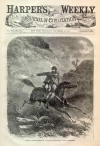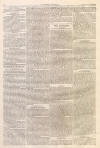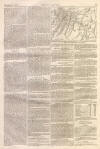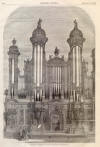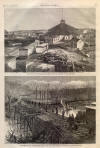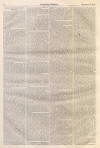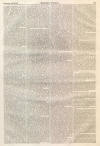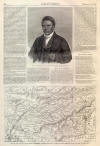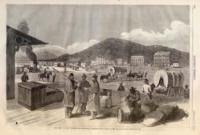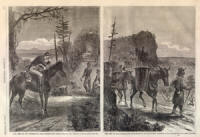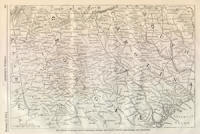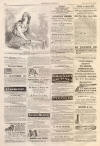Reverend Turner- The First Black Chaplain
|
|
This Site:
|
HARPER'S WEEKLY. [DECEMBER 12, 1863. 796 REVEREND H. M. TURNER, CHAPLAIN FIRST UNITED STATES COLORED REGIMENT.(Previous Page) in the grand proportions of a temple, it has its house built around it. In a noble instance like the present, where an artistic inspiration, a unity of idea, a sense of vital correspondence of the inward and outward presides over and pervades all, the house or outward temple seems rather to have grown up with that which it both hides and reveals, to have risen in its symmetry and grandeur to the music (heard by a fine inner sense) of the organ soul. Nor does the term house do sufficient justice to the beautiful design before us. It is in some sense the body of the organ, the outward visible embodiment of its interiors. Not, to be sure, like the animal or human body, itself composed of organs; but the body of the idea of the organ, the shadowing forth by correspondence of its co-working inner parts and uses, the typifying of all its history and prophecy, as music itself typifies the whole course and prophecy of life. The structure is of black walnut, and is covered with carved statues, busts, masks, and figures in the boldest relief. In the centre a richly ornamented arch contains the niche for the key-boards and stops. A colossal mask of a singing woman looks from over its summit. The pediment above is surmounted by the bust of Johann Sebastian Bach. Behind this rises the lofty central division containing pipes; and crowning it is a beautiful sitting statue of St. Cecilia, holding her lyre. On each side of her a griffin sits as a guardian. This centre is connected by harp-shaped compartments filled with pipes to the two great round towers, one on each side, and each containing three colossal pipes. These magnificent towers come boldly forward into the hall, being the most prominent as they are the highest and stateliest part of the facade. At the base of each, a gigantic half-caryatid, in the style of the ancient hermae, but finished to the waist, bends beneath the superincumbent weight, like Atlas under the globe. These figures are of wonderful force, the muscular development excessive, but in keeping with their superhuman task. At each side of the base, two lion-hermae share in the task of the giant. Over the base rises the round pillars which support the dome, and inclose the three great pipes already mentioned. Graceful as these look in their positions, half a dozen men might creep into one of them and be hidden. The three great pipes are crowned by a heavily sculptured, ribbed rounded dome; and this surmounted on each side by two cherubs, whose heads almost touch the lofty ceiling. This whole portion of the sculpture is of eminent beauty. All the reliefs that run around the lower portion of the dome are of singular richness. The whole base of the instrument, in the intervals of the figures described, is also covered with elaborate carvings. Groups of musical instruments, standing out almost detached from the back-ground, occupy the panels. Ancient and modern, clustered with careless grace and quaint variety, from the violin down to a string of sleigh-bells, they call up all the echoes of forgotten music, such as the thousand-tongued organ blends together in one grand harmony. As we return to the impression produced by the grand facade, we are more and more struck with the subtle art displayed in its adaptations and symbolisms. Never did any structure we have looked upon so fully justify Madame de Stael's definition of architecture—"frozen music." The outermost towers, their pillars and domes, are all square, their outlines thus passing without too sudden transition from the sharp square angles of the vaulted ceiling, and the rectangular lines of the walls of the Hall itself, into the more central parts of the instrument, where a smoother harmony of outline is predominant. For in the great towers, which step forward, as it were, to represent the meaning of the entire structure, the lines are all curved, as if the slight discords which give sharpness and variety to its less vital portions were all resolved as we approach its throbbing heart. And again, the half-fantastic repetition of musical forms in the principal outlines —the lyre-like shape of the bases of the great towers, the harp-like figure of the connecting wings, the clustering reeds of the columns—fill the mind with musical suggestions, and dispose the wondering spectator to become the entranced listener. Dr. Upham thus officially reports of the organ-house find its artist-builders: In regard to the architectural form and enshrinement of the instrument I have time to say but a word. This part of the work the directors approached with no little diffidence and doubt. No structure of the kind that could be found in Europe appeared to meet the somewhat anomalous position that was to be occupied. It was only after months and years of patient effort and trial that the present fitting habitation for so noble an instrument could be obtained. The germ of the structure is a design by Hammatt Billings. His were the outlines of general form and proportion. But in its present embodiment, if we except the cherubs on the tops of the high towers, the germ alone remains. The finally adopted plan, in all its artistic and elaborate beauty and grandeur, belongs to the brothers Gustave and Christian Herter, of New York, whose designs, when submitted to Mr. Billings, were pronounced by him, with characteristic frankness and unselfishness, to be superior to his own, and urged upon the acceptance of the committee. It is impossible to speak in terms of too high praise of the care, attention, and conscientious application on the part of Mr. Herter himself and all in his employ to the work during the two years and more of its construction.—Be it the artist (who in the person of Christian Herter is with us to-night), from whose brain leaped forth, Minerva-like, the finest forms of human and ideal things, or the sculptor by whose cunning these were stiffened into shape and fixed in the willing wood—the modelers in clay and plaster—the carvers, carpenters, and finishers—all labored with one mind toward the perfect result. The inauguration of the great organ was most imposing ceremonial. REV. H. M. TURNER.WE publish herewith a portrait of Rev. H. M. TURNER, the first man of color ever commissioned a chaplain in the United States service. The Rev. H. M. Turner is a native of South Carolina, and is now near thirty-one years of age. He was born in the vicinity of Newberry Court House, grew up to a good-sized boy on the cotton fields with the slaves, and learned to read by his own efforts. His mother, marrying in Abbeville village, carried him there, where he waited on some lawyers, who became so much impressed with his talent, that, in defiance of the prohibition of the law, they took pleasure in instructing him. He would listen to them talk and speak, and then go in the woods and repeat what he had heard. Thus his mind developed, and in his seventeenth year he became a member of the Methodist church. He was licensed to preach in his twentieth year, and displayed such intelligence in his first sermon that he made quite a sensation. From this time forth he attracted great crowds wherever he went. Eventually his name became so well known that white churches were often thrown open to him of all denominations—a circumstance almost unknown, for the law of South Carolina strictly forbids colored men preaching. He traveled through Savannah (Georgia), Montgomery (Alabama), and Mobile, where he was known as the Negro Spurgeon, and every one, white and colored, was rife to see and hear him. After visiting nearly all the great Southern cities, he settled at St. Louis, Missouri, and joined the African Methodist Episcopal Church. Bishop Payne sent him to Baltimore city. In April, 1862, Bishop Payne again sent him to Washington city, to take charge of the large colored church known as the Israel Bethel Church. Here his reputation soon rose, and it was nothing strange last winter to see on Sunday evenings several Congressmen sitting about in the church. In August, 1862, he delivered a sermon on the policy of organizing colored soldiers, which was published in the Washington Republican, and created some stir, and at first considerable opposition. He persevered, however, till he and others friendly to the move were allowed to commence to recruit the regiment of which he is now chaplain. He was commissioned chaplain on the 10th of last September, entered upon active service a few clays afterward, and is now with his regiment on his way to Texas to reinforce the gallant army which is led by General Banks. Mr. Turner is a man of great personal courage: he fears no man and nothing. In large assemblies he can command attention when few others could. His size is ordinary, with yellow complexion and very sharp features. THE SWAMP ANGEL.ANGELS of good and ill are every where; They haunt the city and the cottage lone; Their seen or unseen presence fills the air, And feels the stir of every laugh or moan. And frequent the good angels are the bane Of evil men, who name them evil things; And darkest ministers of death and pain Oft bear the angel light upon their wings. So are they changed. The angel of the wind, That speeds the sailor swiftly o'er the flood, Is the sea demon of the crew behind, Whose hands are eager for the stain of blood. And many a mother has the angel blessed Of the dark swamp, as, with convulsive strain, She clasps her wondering infant to her breast, While baffled blood-hounds lick their chops in vain. Before the wicked city's traitor hold Stands a swamp angel all unangel wise; Perhaps some bondman's prayer has made it bold, Thus to put off its old and unseen guise. And it sends back the hound's deep-throated tone Full with the message of rebounding ill: And the pale hunters curse it with a groan, For the swamp angel is a demon still. MAP OF THE VICINITY OF KNOXVILLE, TENNESSEE, SHOWING THE LINE OF COMMUNICATION BETWEEN KNOXVILLE AND CHATTANOOGA.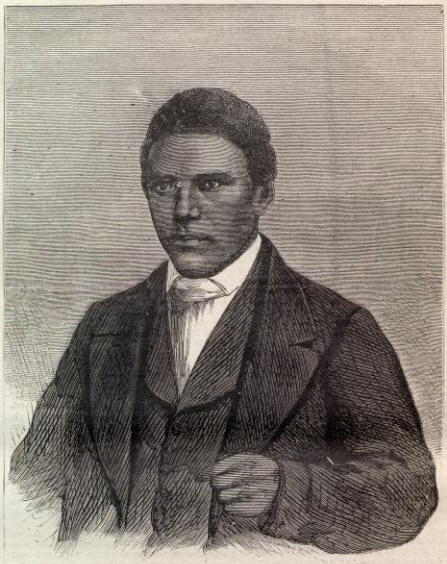 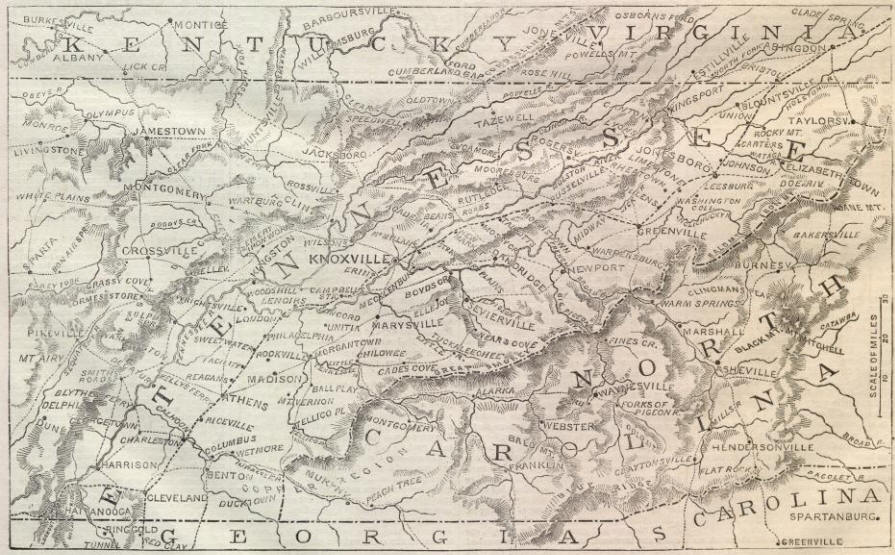 |
||||||||||||||||||||||
|
|
||
|
|
Site Copyright 2003-2018 Son of the South. For Questions or comments about this collection, contact paul@sonofthesouth.net |
|
|
Are you Scared and Confused? Read My Snake Story, a story of hope and encouragement, to help you face your fears. |
||
